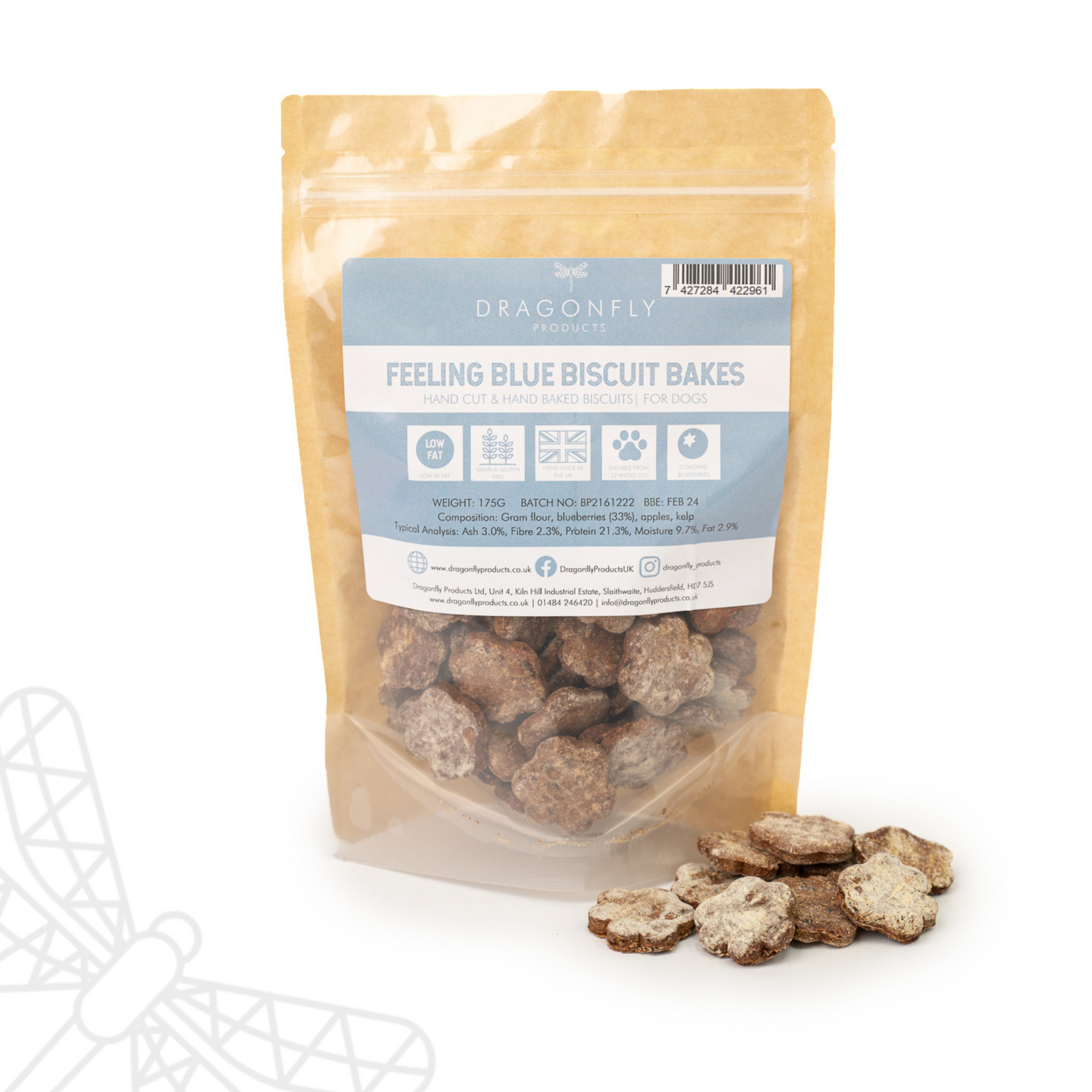
The Do's and Don'ts of Feeding Human Food to Dogs
Feeding processed human food to dogs is a confusing topic with conflicting information. Many dog owners enjoy sharing small tidbits with their pooch and whilst some foods can be safe and even beneficial for dogs, others can cause issues that many owners may not be aware of. Unexplained, itching, diarrhoea and gas are just a few symptoms of feeding human food to dogs - even in small quantities. In this article, we'll explore the safety and implications of feeding your dog some common processed human foods: cheese, crisps, toast, processed meat and cereals such as Weetabix.
Table of Contents
- Can dogs eat cheese?
- Can dogs eat crisps?
- Can dogs eat ham?
- Can dogs eat toast?
- Can dogs eat Weetabix and cereal?
Can dogs eat cheese?
Feeding cheese to dogs can be a contentious topic among pet owners and veterinarians alike. While it has its benefits, it also comes with certain risks.
The risks of feeding cheese to dogs
- Lactose Intolerance: Many dogs are lactose intolerant, which means they have difficulty digesting lactose, a sugar found in dairy products. Feeding cheese to lactose-intolerant dogs can lead to gastrointestinal issues such as diarrhoea, gas, and bloating.
- High Fat Content: Cheese is high in fat, which can contribute to obesity if fed in large quantities or too frequently. Obesity in dogs can lead to various health problems, including heart disease, diabetes, and joint issues.
- Risk of Pancreatitis: The high fat content in cheese can also increase the risk of pancreatitis, a serious condition where the pancreas becomes inflamed. This condition requires immediate veterinary attention and can be life-threatening if not treated promptly.
- Salt Content: Some cheeses contain high levels of salt, which can be harmful to dogs. Excessive salt intake can lead to sodium ion poisoning, causing symptoms like vomiting, diarrhoea, tremors, and even seizures.
- Caloric Intake: Cheese is calorie-dense, and feeding too much can quickly add up to a significant portion of your dog's daily caloric intake. This can lead to an imbalance in their diet and potential weight gain.
- Potential Allergens: Cheese can contain additives, preservatives, or artificial flavours that might cause allergic reactions in some dogs. Always check the ingredients to ensure the cheese is free from harmful additives.
Guidelines for feeding cheese to your dog
To safely incorporate cheese into your dog's diet, follow these guidelines:
- Moderation: Offer cheese in small amounts to prevent any adverse reactions and monitor your dog's response.
- Choose Wisely: Opt for low-fat, low-sodium cheeses and avoid those with added flavours or preservatives.
- Monitor for Intolerance: Watch for signs of lactose intolerance, such as diarrhoea or gas, and discontinue feeding cheese if these occur.
- Use as a Treat: Treat cheese as an occasional reward rather than a regular part of your dog's diet to avoid excessive calorie and fat intake.
Safe alternatives to cheese for dogs
We love to feed dog friendly pate which has the same high value appeal as cheese but without the potential side effects listed above. Pate can be cubed, grated and mashed, much like cheese can with the added benefit of being freezable to keep it fresh for longer.
Can dogs eat crisps?
Crisps, also known as potato chips, are a popular snack for humans, but their suitability for dogs is highly debatable. While crisps might seem like a harmless snack, their high salt and fat content, along with the potential for toxic additives, make them a poor choice for dogs. The risks associated with feeding crisps to your dog far outweigh the minor benefits of convenience and palatability. For the sake of your dog’s health, it’s best to stick to treats specifically designed for canine consumption and reserve crisps for human enjoyment only.
The risks of feeding crisps to dogs
- High Salt Content: Crisps are typically very high in salt, which can be harmful to dogs. Excessive salt intake can lead to sodium ion poisoning, a condition that can cause symptoms such as vomiting, diarrhoea, tremors, seizures, and even death. Dogs have a much lower tolerance for salt compared to humans, making even a small amount potentially dangerous.
- High Fat Content: The high fat content in crisps can lead to obesity and pancreatitis in dogs. Pancreatitis is a serious condition characterised by inflammation of the pancreas, which can cause severe abdominal pain, vomiting, and lethargy.
- Risk of Toxicity: Many crisps are flavored with ingredients that can be toxic to dogs, such as onion powder, garlic, and artificial flavourings. Even in small amounts, these additives can cause health issues ranging from gastrointestinal upset to severe poisoning.
- Caloric Density: Crisps are calorie-dense, and feeding them to your dog can contribute significantly to their daily caloric intake. This can lead to an imbalance in their diet and potential weight gain, increasing the risk of obesity-related health problems.
- Lack of Nutritional Value: Crisps offer little to no nutritional value for dogs. They are essentially empty calories, devoid of the essential nutrients dogs need for a balanced diet. Regularly feeding crisps can displace more nutritious foods from their diet, leading to deficiencies.
- Digestive Issues: The high fat and salt content in crisps can cause digestive issues in dogs, such as diarrhoea, vomiting, and general gastrointestinal discomfort. Dogs with sensitive stomachs are particularly prone to these issues.
- Additives and Preservatives: Many crisps contain artificial additives and preservatives that are not suitable for dogs. These substances can cause allergic reactions, digestive problems, and long-term health issues.
Guidelines for feeding crisps to your dog
Given the numerous cons, it’s generally advisable to avoid feeding crisps to your dog. However, if you choose to offer crisps occasionally, follow these guidelines:
- Limit Quantity: Offer crisps in very small amounts and only as an extremely rare treat.
- Choose Plain Varieties: Opt for plain, unsalted crisps without any added flavors, preservatives, or toxic ingredients.
- Monitor for Adverse Reactions: Watch for any signs of gastrointestinal upset or other adverse reactions and discontinue feeding crisps if these occur.
Safe alternatives to crisps for dogs
Doggy Crisps are a great alternative to human crisps. Dehydrated sweet potato slices, drizzled with honey and peanut butter make a satisfying snack for your dog whilst steering clear of the high fat and salt content of this popular human snack.
Can dogs eat ham?
Ham is a popular processed meat that many people enjoy, but when it comes to sharing it with dogs, there are several factors to consider. While ham can be a tasty and protein-rich treat for dogs, its high salt and fat content, along with the potential for harmful preservatives and seasonings, make it a risky choice. The cons often outweigh the pros, especially if ham is fed in large quantities or on a regular basis. To ensure your dog's health and well-being, it's best to offer ham sparingly and with careful consideration, or opt for healthier treat alternatives specifically designed for dogs.
The risks of feeding ham to dogs
- High Salt Content: One of the biggest concerns with feeding ham to dogs is its high sodium content. Excessive salt intake can lead to sodium ion poisoning, causing symptoms such as vomiting, diarrhea, tremors, seizures, and even death in severe cases. Dogs are much more sensitive to salt than humans, so even small amounts can be problematic.
- High Fat Content: Ham is also high in fat, which can contribute to obesity and pancreatitis in dogs. Pancreatitis is a serious condition characterized by inflammation of the pancreas and can cause severe abdominal pain, vomiting, and lethargy.
- Preservatives and Additives: Processed hams often contain preservatives, such as nitrates and nitrites, which can be harmful to dogs. Additionally, some hams have added sugars and artificial flavors that are not suitable for canine consumption.
- Risk of Toxicity: Some hams are seasoned with ingredients like onion, garlic, or other spices that are toxic to dogs. Even small amounts of these seasonings can cause health issues ranging from gastrointestinal upset to severe poisoning.
- Caloric Density: Ham is calorie-dense, and feeding it to your dog can quickly add up to a significant portion of their daily caloric intake. This can lead to weight gain and associated health problems, especially if given regularly or in large quantities.
- Potential for Allergies: Some dogs may be allergic to pork or other ingredients in processed ham. Allergic reactions can manifest as skin irritations, gastrointestinal issues, or respiratory problems.
Guidelines for feeding ham to your dog
If you decide to give ham to your dog, it’s important to do so with caution and moderation. Here are some guidelines to follow:
- Limit Quantity: Offer ham in very small amounts and only as an occasional treat, not as a regular part of their diet.
- Choose Unseasoned Varieties: Opt for plain, unseasoned ham without any added salt, sugar, or spices. Avoid hams that contain preservatives like nitrates or nitrites.
- Monitor for Reactions: Watch for any signs of digestive upset, allergic reactions, or other adverse effects after feeding ham to your dog. If any symptoms occur, discontinue feeding ham immediately.
- Balance the Diet: Ensure that the rest of your dog’s diet is balanced and nutritious, providing all the essential nutrients they need without relying on processed meats.
Safe alternatives to ham
The perfect alternative to ham are snacks such as Just Meat Strips or Sticks which are 100% pure protein, air dried with no additives or salt. Tasty and wholesome, they can be enjoyed by all breeds, ages and size of dog as a healthy treat.
Can dogs eat toast?
Toast is a common breakfast item that many people enjoy, but when it comes to sharing it with dogs, there are several aspects to consider. While plain toast can be a safe and convenient treat for dogs in small quantities, it offers limited nutritional value and carries potential risks, especially if it contains harmful additives or is paired with unhealthy toppings. Toast also contains gluten and grain which, for many dogs, can cause itching and symptoms of intolerance. To ensure your dog's health and well-being, it’s best to offer toast sparingly and with careful consideration, opting for healthier treat alternatives when possible
The risks of feeding toast to dogs
- Lack of Nutritional Value: While toast provides carbohydrates, it lacks significant nutritional value, particularly if made from white bread. Whole grain varieties are better but still do not offer a balanced nutritional profile for dogs.
- Potential for Allergies: Some dogs may have allergies or sensitivities to wheat or gluten, which are common ingredients in bread. Feeding toast to these dogs can lead to digestive upset, skin issues, or other allergic reactions.
- Additives and Preservatives: Many commercial breads contain additives, preservatives, and even sweeteners that can be harmful to dogs. Ingredients like xylitol, a common artificial sweetener, are toxic to dogs and can cause severe health problems.
- Toppings and Spreads: Toast is often served with various toppings and spreads, many of which are unsuitable or dangerous for dogs. Butter, margarine, jam, jelly, peanut butter (especially those with xylitol), and other spreads can introduce unhealthy fats, sugars, and toxic substances into your dog's diet.
- Caloric Density: While plain toast is relatively low in calories, it can still contribute to an excessive caloric intake if given in large amounts, especially for small dogs or those with weight management issues. Overfeeding toast can lead to weight gain and associated health problems.
- Dental Health: Toast can be hard and crunchy, which might be difficult for some dogs to chew, particularly those with dental issues or older dogs. Hard toast can potentially damage their teeth or gums.
Guidelines for feeding toast to your dog
If you decide to offer toast to your dog, it’s important to do so with caution and moderation. Here are some guidelines to follow:
- Plain and Simple: Offer plain, unbuttered toast without any toppings or spreads. Avoid bread varieties that contain harmful ingredients like raisins, nuts, or seeds.
- Choose Whole Grain: Opt for whole grain bread rather than white bread for a slightly better nutritional profile. Whole grain bread contains more fibre and nutrients.
- Small Quantities: Feed toast in small amounts and only as an occasional treat, not as a regular part of their diet.
- Monitor for Allergies: Watch for any signs of allergies or sensitivities, such as itching, digestive upset, or skin irritations. If any symptoms occur, discontinue feeding toast immediately.
- Check Ingredients: Always check the ingredients of the bread to ensure it does not contain any harmful additives, preservatives, or artificial sweeteners like xylitol.
Safe alternatives to toast
If your dog enjoys the crunch of toast, why not opt for something equally crunchy but without the grain such as dried Beef Tripe Sticks? This natural snack will give your dog the same enjoyment as toast but avoids any potential irritation from the grain and gluten contained within the bread.
Can dogs eat Weetabix and cereal?
Cereals like Weetabix are popular breakfast options for humans, but their suitability for dogs can vary significantly. While some cereals can be shared with dogs, others contain ingredients that may be harmful.
The risks of feeding Weetabix to dogs
- Contains Gluten: Weetabix and many cereals contain gluten, which can cause digestive issues for dogs that are sensitive to gluten. Symptoms of gluten intolerance include diarrhoea, bloating, and stomach discomfort.
- High in Carbohydrates: While carbohydrates can provide energy, an excessive amount can lead to weight gain and obesity, especially if the dog is not very active. Dogs' primary nutritional needs are met through protein and fats rather than carbohydrates.
- Possible Additives and Sweeteners: Some cereals contain additives, artificial flavours, and sweeteners that can be harmful to dogs. Ingredients like xylitol are toxic to dogs and can cause severe health issues.
- Sugar Content in Some Cereals: While Weetabix is low in sugar, many other cereals are high in sugar, which can lead to dental problems, obesity, and even diabetes in dogs. It's essential to avoid cereals with added sugars.
- Lack of Protein: Cereals are generally low in protein, which is a crucial component of a dog's diet. Relying too much on cereals can lead to a protein deficiency, affecting muscle maintenance and overall health.
- Potential for Allergens: Aside from gluten, cereals can contain other allergens like soy, corn, and certain preservatives. These allergens can cause allergic reactions or digestive issues in some dogs.
Guidelines for feeding Weetabix and cereals to your dog
If you decide to feed Weetabix or other cereals to your dog, it’s important to do so with caution and moderation. Weetabix and cereal contains gluten and grain which, for many dogs, can cause itching and symptoms of intolerance. If you are feeding Weetabix for fibre, there are better, more natural alternatives out there.
- Plain and Unsweetened: Offer plain, unsweetened cereals without any added flavours, sugars, or artificial sweeteners. Avoid cereals with raisins, chocolate, or other toxic ingredients.
- Small Quantities: Feed cereals in small amounts and only as an occasional treat, not as a primary food source.
- Monitor for Allergies: Watch for any signs of allergies or digestive issues, such as itching, vomiting, or diarrhoea. If any symptoms occur, discontinue feeding cereals immediately.
- Check Ingredients: Always check the ingredients list to ensure the cereal does not contain harmful additives, preservatives, or toxic substances like xylitol.
- Balanced Diet: Ensure that the rest of your dog’s diet is balanced and rich in the necessary proteins and fats that cereals lack.
Safe alternatives to Weetabix
If it is fibre you want to add to your dog’s diet, opt for Veggie Crumble which can be sprinkled into your dog’s food for added bulk, or lightly steam broccoli, carrots and sweet potato to give them that extra nutrition but without the added sugars, grain and gluten that is contained within Weetabix.
Feeding human food to dogs should be based on common sense. In a perfect world, dogs wouldn’t be fed processed human food but most dog owners (myself included), from time to time, like to share a snack with their beloved pooch. However, if your dog has inexplicable symptoms such as itching, upset digestion or something else that you can’t get to the bottom of, consider whether human food could be the culprit!
For any further help and advice please contact us on 01484 246420 and why not join our social media channels and online community on Instagram, Facebook or YouTube.
With Wags and Woofs,
Laura, Dolly & Reggie







